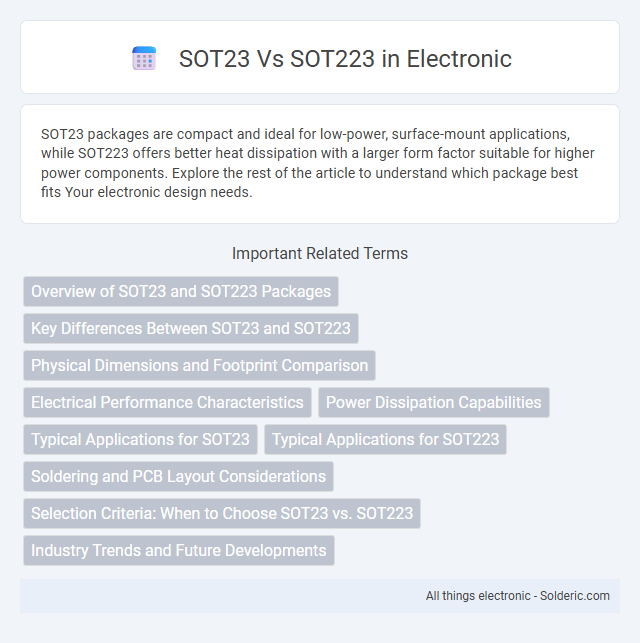SOT23 packages are compact and ideal for low-power, surface-mount applications, while SOT223 offers better heat dissipation with a larger form factor suitable for higher power components. Explore the rest of the article to understand which package best fits Your electronic design needs.
Comparison Table
| Feature | SOT-23 | SOT-223 |
|---|---|---|
| Package Type | Small Outline Transistor | Small Outline Transistor |
| Dimensions | 2.9 mm x 1.3 mm approx. | 6.7 mm x 3.7 mm approx. |
| Lead Count | 3 leads | 3 to 5 leads (commonly 4) |
| Thermal Resistance | Higher (worse heat dissipation) | Lower (better heat dissipation) |
| Power Dissipation | Typically 350 mW max | Up to 1-2 W (depending on PCB) |
| Application | Low power, space-constrained circuits | Medium power, power regulation, and amplification |
| Mounting | Surface-mount | Surface-mount with larger heat tab |
Overview of SOT23 and SOT223 Packages
SOT23 and SOT223 are popular surface-mount transistor packages used in electronics for their compact design and ease of PCB assembly. SOT23 features a small, three-pin configuration ideal for low-power applications, while SOT223 is larger with more pins, offering better heat dissipation suited for higher power components. Understanding the thermal and size differences between these packages helps you choose the right one for your circuit's performance and space requirements.
Key Differences Between SOT23 and SOT223
SOT23 packages are compact, typically featuring three pins and a size around 2.9 x 1.6 mm, making them ideal for low-power, space-constrained applications. In contrast, SOT223 packages are larger, usually with four pins and dimensions around 6.7 x 3.7 mm, designed to handle higher power dissipation due to their enhanced thermal performance. The key differences include physical size, pin count, and power handling capability, where SOT223 supports greater current and thermal loads compared to SOT23.
Physical Dimensions and Footprint Comparison
SOT23 packages typically measure around 2.9 mm x 1.3 mm, offering a compact footprint ideal for high-density PCB layouts. In contrast, SOT223 packages are larger, approximately 6.7 mm x 3.7 mm, designed to handle higher power dissipation with increased thermal performance. Choosing between SOT23 and SOT223 depends on your space constraints and thermal management needs in your circuit design.
Electrical Performance Characteristics
SOT23 packages offer low parasitic capacitance and inductance, making them suitable for high-frequency applications and low-power devices. In contrast, SOT223 packages provide better thermal dissipation and can handle higher current ratings, resulting in improved electrical performance in power-sensitive circuits. Selecting between SOT23 and SOT223 depends on the application's voltage, current requirements, and thermal management needs for optimal performance.
Power Dissipation Capabilities
SOT223 packages offer significantly higher power dissipation capabilities compared to SOT23, with typical maximum ratings around 1 to 2 watts versus SOT23's 0.3 to 0.5 watts, making SOT223 suitable for applications requiring effective heat management. The larger surface area and improved thermal performance of SOT223 help maintain device reliability in higher power applications. When selecting a package for your design, consider the power dissipation requirements to ensure optimal thermal handling and performance.
Typical Applications for SOT23
SOT23 packages are widely used in surface-mount technology for small-signal transistors, diodes, and voltage regulators, offering compact footprint ideal for portable electronics, smartphones, and battery-powered devices. Their ability to handle low power dissipation suits applications like signal amplification, voltage switching, and small-scale power management. Choosing SOT23 ensures your designs benefit from efficient space utilization in compact, high-density circuit boards.
Typical Applications for SOT223
SOT223 packages are widely used in power regulators, voltage converters, and amplifiers due to their superior power dissipation capabilities compared to SOT23. These components suit applications requiring moderate power handling and thermal management, such as linear voltage regulators or small power transistors in power management circuits. Your choice of SOT223 over SOT23 should consider the current rating and heat dissipation needs essential for stable operation in these embedded system applications.
Soldering and PCB Layout Considerations
SOT23 packages, being smaller and with three pins, require precise soldering techniques and tighter PCB pad layouts to prevent solder bridging, making them ideal for compact designs but challenging for manual assembly. SOT223 footprints are larger with four or more pins, providing easier heat dissipation and more generous pad spacing that simplifies soldering and improves thermal management on PCB layouts. Designers must balance the compactness of SOT23 with the robust thermal and assembly benefits of SOT223 depending on the application's soldering method and thermal requirements.
Selection Criteria: When to Choose SOT23 vs. SOT223
Choose SOT23 package for compact, low-power applications requiring minimal PCB space and simpler thermal management. Opt for SOT223 when higher power dissipation and improved heat sinking are necessary, as its larger size facilitates better thermal performance. Selection depends on balancing size constraints with power and thermal requirements in electronic circuit design.
Industry Trends and Future Developments
SOT23 and SOT223 packages are evolving to meet the demands of miniaturization and increased power efficiency in electronics, with SOT23 favored for compact, low-power applications and SOT223 preferred in thermal management and higher current scenarios. Industry trends indicate a shift toward integrating advanced materials and improved thermal conductivity within these packages to enhance performance and reliability in consumer electronics and automotive sectors. Your choice between SOT23 and SOT223 should consider future developments in power density requirements and packaging innovation to ensure optimal device longevity and functionality.
SOT23 vs SOT223 Infographic

 solderic.com
solderic.com